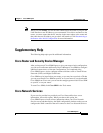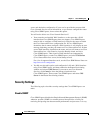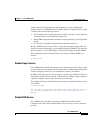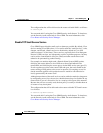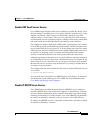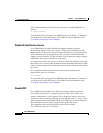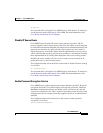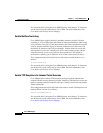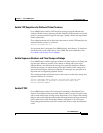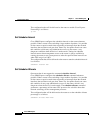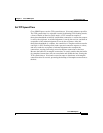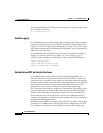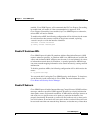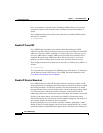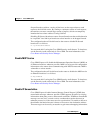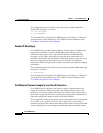
1-33
Cisco SDM Express
OL-7141-04
Chapter 1 Cisco SDM Express
Supplementary Help
Enable TCP Keepalives for Outbound Telnet Sessions
Cisco SDM Express enables TCP keepalive messages for both inbound and
outbound Telnet sessions whenever possible. Enabling TCP keepalives causes the
router to generate periodic keepalive messages, letting it detect and drop broken
Telnet connections.
The configuration that will be delivered to the router to enable TCP keepalives for
outbound Telnet sessions is as follows:
service tcp-keepalives-out
You can undo this fix using the Cisco SDM Security Audit feature. To learn how,
see the Security Audit online help in Cisco SDM. For more information, click
Cisco Router and Security Device Manager.
Enable Sequence Numbers and Time Stamps on Debugs
Cisco SDM Express enables sequence numbers and time stamps on all debug and
log messages whenever possible. Time stamps on debug and log messages
indicate the time and date that the message was generated. Sequence numbers
indicate the sequence in which messages that have identical time stamps were
generated. Knowing the timing and sequence that messages are generated is an
important tool in diagnosing potential attacks.
The configuration that will be delivered to the router to enable time stamps and
sequence numbers is as follows:
service timestamps debug datetime localtime show-timezone msec
service timestamps log datetime localtime show-timeout msec
service sequence-numbers
Enable IP CEF
Cisco SDM Express enables Cisco Express Forwarding or Distributed Cisco
Express Forwarding whenever possible. Because there is no need to build cache
entries when traffic starts arriving at new destinations, Cisco Express Forwarding
behaves more predictably than other modes when presented with large volumes of
traffic addressed to many destinations. Routes configured for Cisco Express
Forwarding perform better under SYN attacks than routers using the traditional
cache.



